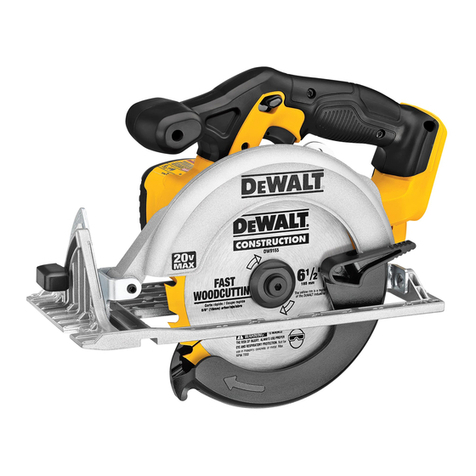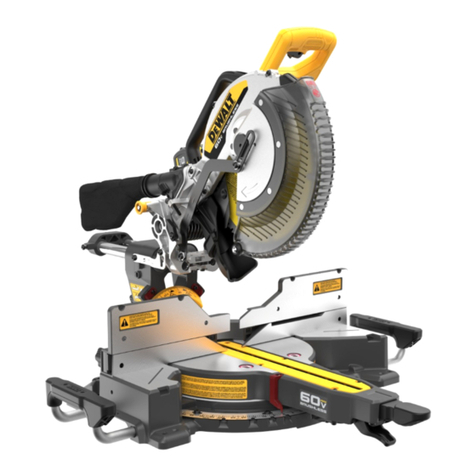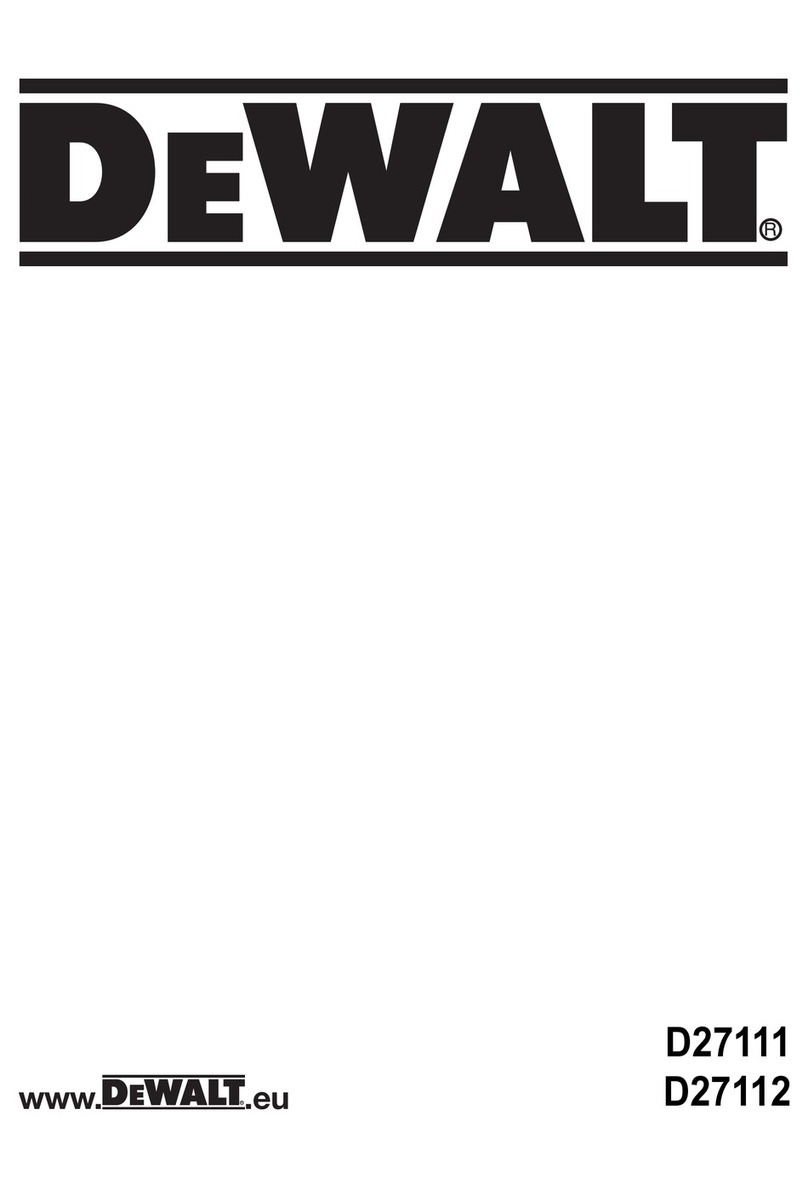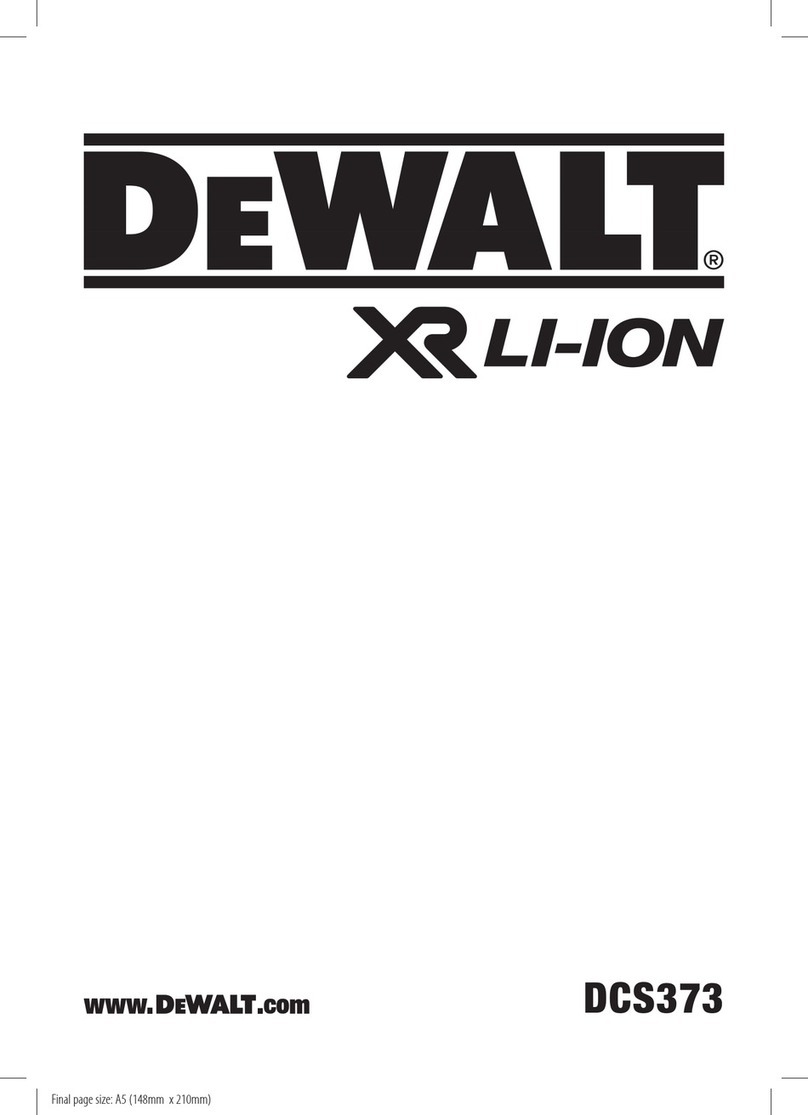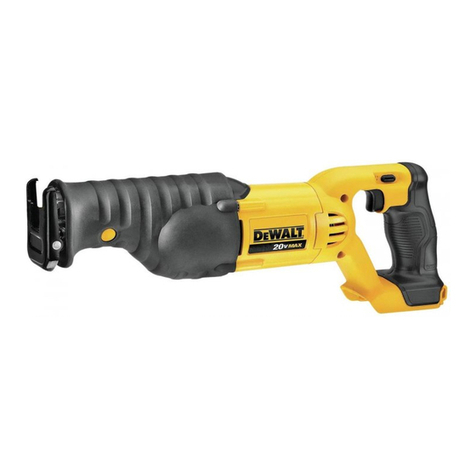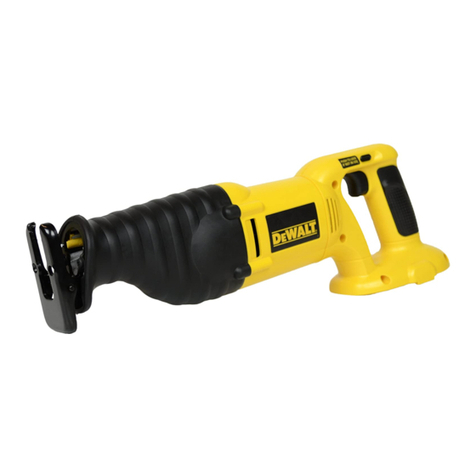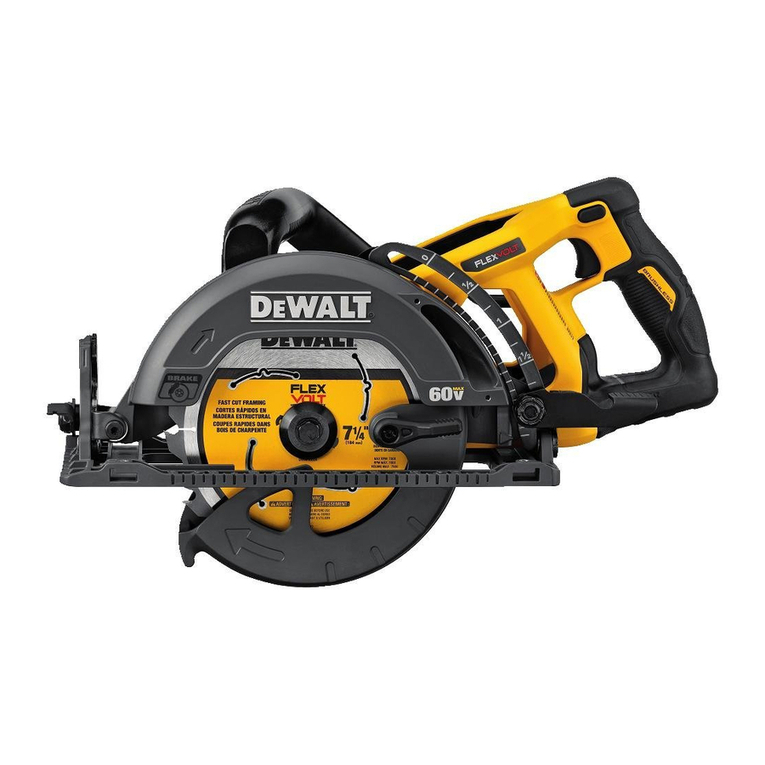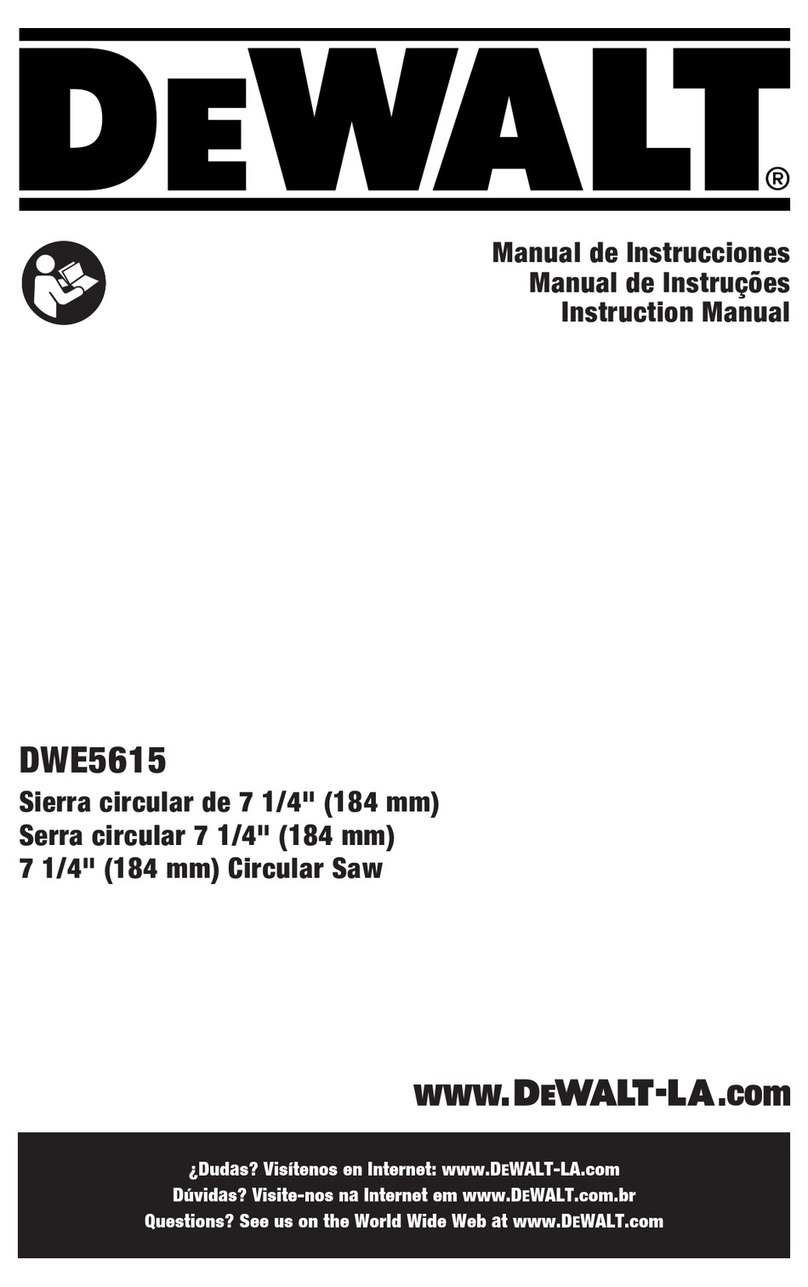
ENGLISH
3
j ) Feed workpiece at an even pace. Do not bend or twist the workpiece. If jamming
occurs, turn the tool off immediately, unplug the tool then clear the jam. Jamming
the saw blade by the workpiece can cause kickback or stall themotor.
k ) Do not remove pieces of cut-off material while the saw is running. The material may
become trapped between the fence or inside the saw blade guard and the saw blade
pulling your fingers into the saw blade. Turn the saw off and wait until the saw blade
stops before removingmaterial.
l ) Use an auxiliary fence in contact with the table top when ripping workpieces less
than 2 mm thick. A thin workpiece may wedge under the rip fence and create akickback.
3) Kickback Causes and Related Warnings
Kickback is a sudden reaction of the workpiece due to a pinched, jammed saw blade or misaligned
line of cut in the workpiece with respect to the saw blade or when a part of the workpiece binds
between the saw blade and the rip fence or other fixedobject.
Most frequently during kickback, the workpiece is lifted from the table by the rear portion of the saw
blade and is propelled towards theoperator.
Kickback is the result of saw misuse and/or incorrect operating procedures or conditions and can be
avoided by taking proper precautions as givenbelow.
a ) Never stand directly in line with the saw blade. Always position your body on the
same side of the saw blade as the fence. Kickback may propel the workpiece at high
velocity towards anyone standing in front and in line with the sawblade.
b ) Never reach over or in back of the saw blade to pull or to support the workpiece.
Accidental contact with the saw blade may occur or kickback may drag your fingers into the
sawblade.
c ) Never hold and press the workpiece that is being cut off against the rotating saw
blade. Pressing the workpiece being cut off against the saw blade will create a binding
condition andkickback.
d ) Align the fence to be parallel with the saw blade. A misaligned fence will pinch the
workpiece against the saw blade and createkickback.
e ) Use a featherboard to guide the workpiece against the table and fence when
making non-through cuts such as rabbeting, dadoing or resawing. A featherboard
helps to control the workpiece in the event of akickback.
f ) Use extra caution when making a cut into blind areas of assembled workpieces. The
protruding saw blade may cut objects that can cause kickback.
g ) Support large panels to minimise the risk of saw blade pinching and kickback. Large
panels tend to sag under their own weight. Support(s) must be placed under all portions
of the panel overhanging the tabletop.
h ) Use extra caution when cutting a workpiece that is twisted, knotted, warped or does
not have a straight edge to guide it with a miter gauge or along the fence. A warped,
knotted, or twisted workpiece is unstable and causes misalignment of the kerf with the saw
blade, binding andkickback.
i ) Never cut more than one workpiece, stacked vertically or horizontally. The saw blade
could pick up one or more pieces and causekickback.
j ) When restarting the saw with the saw blade in the workpiece, center the saw blade
in the kerf so that the saw teeth are not engaged in the material. If the saw blade
binds, it may lift up the workpiece and cause kickback when the saw isrestarted.
k ) Keep saw blades clean, sharp, and with sufficient set. Never use warped saw blades
or saw blades with cracked or broken teeth. Sharp and properly set saw blades minimise
binding, stalling andkickback.
4) Table Saw Operating Procedure Warnings
a ) Turn off the table saw and disconnect from the power source when removing the
table insert, changing the saw blade or making adjustments to the riving knife,
anti-kickback pawls or saw blade guard, and when the machine is left unattended.
Precautionary measures will avoidaccidents.
b ) Never leave the table saw running unattended. Turn it off and don’t leave the tool
until it comes to a complete stop. An unattended running saw is an uncontrolledhazard.
c ) Locate the table saw in a well-lit and level area where you can maintain good
footing and balance. It should be installed in an area that provides enough room to
easily handle the size of your workpiece. Cramped, dark areas, and uneven slippery floors
inviteaccidents.
d ) Frequently clean and remove sawdust from under the saw table and/or the dust
collection device. Accumulated sawdust is combustible and may self-ignite.
e ) The table saw must be secured. A table saw that is not properly secured may move or
tipover.
f ) Remove tools, wood scraps, etc. from the table before the table saw is turned on.
Distraction or a potential jam can bedangerous.
g ) Always use saw blades with correct size and shape (diamond versus round) of arbor
holes. Saw blades that do not match the mounting hardware of the saw will run off-center,
causing loss ofcontrol.
h ) Never use damaged or incorrect saw blade mounting means such as flanges, saw
blade washers, bolts or nuts. These mounting means were specially designed for your saw,
for safe operation and optimumperformance.
i ) Never stand on the table saw, do not use it as a stepping stool. Serious injury could
occur if the tool is tipped or if the cutting tool is accidentallycontacted.
j ) Make sure that the saw blade is installed to rotate in the proper direction. Do not
use grinding wheels, wire brushes, or abrasive wheels on a table saw. Improper saw
blade installation or use of accessories not recommended may cause seriousinjury.
Additional Safety Rules for Table Saws
WARNING: Cutting plastics, sap coated wood, and other materials may cause melted
material to accumulate on the blade tips and the body of the saw blade, increasing the risk of
blade overheating and binding whilecutting.
• AVOID AWKWARD POSITIONS, where a sudden slip could cause a hand to move into a
sawblade.
• Do not attempt to retrieve materials near the blade on the saw table while the blade isspinning.
• NEVER REACH IN BACK OF, OR AROUND, THE CUTTING TOOL with either hand to hold
down theworkpiece.
• KEEP ARMS, HANDS AND FINGERS AWAY from the blade to prevent seriousinjury.
• USE A PUSH STICK THAT IS APPROPRIATE TO THE APPLICATION TO PUSH
WORKPIECES THROUGH THE SAW. A push stick is a wooden or plastic stick, often
homemade, that should be used whenever the size or shape of the workpiece would cause you to
place your hands within 6" (152mm) of theblade.
• USE HOLDDOWNS, JIGS, FIXTURES OR FEATHER BOARDS TO HELP GUIDE AND
CONTROL THE WORKPIECE. Accessories for use with your tool are available at extra cost from
your local dealer or authorized service center. Instructions for making a push stick, a narrow rip
auxiliary fence, a push block and feather boards are included in thismanual.
• DO NOT PERFORM RIPPING, CROSSCUTTING OR ANY OTHER OPERATIONFREEHAND.
• NEVER reach around or over sawblade while the blade isspinning.
• STABILITY. Make sure the table saw is firmly mounted to a secure surface before use and does
notmove.
• THE TABLE SAW SHOULD ONLY BE SET UP ON A LEVEL AND STABLE SURFACE. The work
area should be free from obstructions and trip hazards. No materials or tools should be leaned
against thesaw.
• NEVER CUT METALS, CEMENT BOARD OR MASONRY. Certain man-made materials have
special instructions for cutting on table saws. Follow the manufacturer’s recommendations at all
times. Damage to the saw and personal injury mayresult.
• Do not install a diamond masonry blade and attempt to use the table saw as a wetsaw.
• THE PROPER THROAT PLATE MUST BE LOCKED IN PLACE AT ALL TIMES to reduce the risk
of a thrown workpiece and possibleinjury.
• WEAR GLOVES WHEN HANDLING SAWBLADES.
• USE THE CORRECT SAW BLADE FOR THE INTENDED OPERATION. The blade must rotate
toward the front of the saw. Always tighten the blade arbor nut securely. Before use, inspect the
blade for cracks or missing teeth. Do not use a damaged or dullblade.
• NEVER ATTEMPT TO FREE A STALLED SAW BLADE WITHOUT FIRST TURNING THE
MACHINE OFF AND DISCONNECT THE PLUG FROM THE POWER SOURCE. If a workpiece
or cut-off piece becomes trapped inside the blade guard assembly, turn saw off and wait for
blade to stop before lifting the blade guard assembly and removing thepiece.
• NEVER START THE MACHINE with the workpiece against the blade to reduce the risk of a
thrown workpiece and personalinjury.
• DO NOT HAVE ANY PART OF YOUR BODY IN LINE WITH THE BLADE. Personal injury may
occur. Stand to either side of theblade.
• NEVER PERFORM LAYOUT, ASSEMBLY OR SETUP WORK on the table/work area when
the machine is running. A sudden slip could cause a hand to move into the blade. Severe injury
canresult.
• NEVER PERFORM ANY ADJUSTMENTS WHILE THE SAW IS RUNNING such as fence
repositioning or removal, bevel lock adjustment, or blade heightadjustment.
• CLEAN THE TABLE/WORK AREA BEFORE LEAVING THE MACHINE. Lock the switch in the
“OFF” position and disconnect the plug from the power source to prevent unauthorizeduse.
• ALWAYS lock the fence and bevel adjustment beforecutting.
• AVOID OVERHEATING THE SAW BLADE TIPS. Keep material moving and parallel with the
fence. Do not force work into theblade.
• IF CUTTING PLASTIC MATERIALS, AVOID MELTING THEPLASTIC.
• DO NOT leave a long board (or other workpiece) unsupported so the spring of the board
causes it to shift on the table resulting in loss of control and possible injury. Provide
proper support for the workpiece, based on its size and the type of operation to be performed.
Hold the work firmly against the fence and down against the tablesurface.
• IF THIS SAW makes an unfamiliar noise or if it vibrates excessively, cease operating immediately,
turn unit off and disconnect the plug from the power source until the problem has been located
and corrected. Contact a
factory service center, a
authorized service center or
other qualified service personnel if the problem can not befound.
• DO NOT OPERATE THIS MACHINE until it is completely assembled and installed according to
the instructions. A machine incorrectly assembled can cause seriousinjury.
• NEVER attempt to cut a stack of loose pieces of material which could cause loss of control or
kickback. Support all materialssecurely.
• NEVER USE FOR TAPERED CUTTING.


